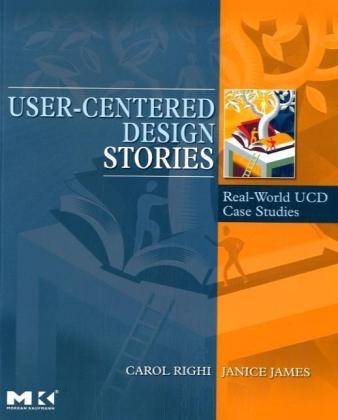Read more
Informationen zum Autor Carol Righi is a Director of User Experience at Perficient. Carol has worked in User-Centered Design for more than 20 years and is widely considered a UCD thought leader. Carol has performed user research, usability evaluation, and interaction design for companies such as IBM, Google, Yahoo, Intuit, A. G. Edwards, Mapquest, Met Life, and many others. She has served as manager for numerous UCD efforts and has helped lead the development of the UCD competency in various organizations, including IBM. Carol has also designed and developed many standup and e-learning courses in UCD and has trained thousands of students. She received her undergraduate degree in psychology in 1981 and her Ph.D. in school/educational psychology with a concentration in computer applications to education in 1988, both from Fordham University in New York City. Janice James is Director of User Experience at Perficient and has more than 18 years of experience in the field of human factors, usability and user-centered design and development for software, hardware, travel, Internet, financial services, education, health care and retail products and services. During the last eight years as principal of her own consulting firm, Simply Usable through Design, she has focused on providing usability engineering and interface design consulting services to companies ranging in size from start-ups to Fortune 500s, including CNet, AOL/Netscape, Hewlett Packard, Unisys, Intuit, Humana, BestBuy.com, eBay, AARP and McGraw-Hill, to name a few. Janice has a broad range of experience in all types of usability and user-centered design processes. She also founded the Kentuckiana Chapter of STC and co-founded the Society for Technical Communications’ Professional Interest Committee on Usability. Klappentext Interaction design practitioners at all levels face new situations--some even a seasoned professional may not have encountered. This book addresses the need of gaining practical knowledge in a short time by its method of eliciting the kind of critical thinking required! and gives readers the kind of experience they can only otherwise get with lots of time on the job. Zusammenfassung A design casebook in which the reader is asked to perform analysis of dozens of UCD work situations and propose solutions for the problem set. It contains problems that cover a variety of key tasks and issues facing practitioners! including those that are related to organizational/managerial topics! and UCD methods and processes. ...
List of contents
Justifying, developing, and starting a UCD Program; Raising awareness and educating others in the work enviornment; Hiring UCD professionals; Estimating and pricing a UCD effort; Selecting appropriate user research methodologies; Selecting appropriate evaluation methodologies; Designing a user iterface; Designing user help; Web site information architecture; Addressing accessibility issues (i.e. designing for those with disabilities); Applying UCD to middleware/products with no obvious user interface; Managing the politics of UCD in the Workplace; Recruiting for a UCD effort; Developing and delivering UCD training; Interplay of the business model/business requirements and user requirements; Cost-Justifying a UCD effort.
Report
As interaction design practitioners at all levels change jobs and get promoted, there are many new situtations to face--many of which even a seasoned professional may not have encountered. Because with UCD there is often no one correct answer, there is a complexity with tradeoffs and solutions that require critical thinking and the application of the existing knowledge base. This book addresses this need by its method of eliciting the kind of critical thinking required, and will give readers the kind of experience they can only otherwise get with lots of time on the job.

